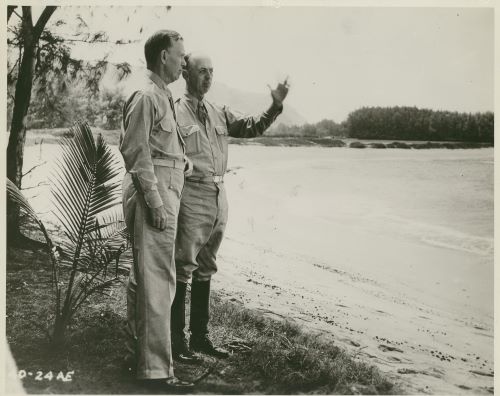“The big thing I learned in World War II was the urgent necessity of frequent visits … I was abreast of what was going on all over the place. I could sense their reactions and I could see how they felt urgently about this or that, which we at headquarters did not really feel so much, but I would come to an understanding in those ways and I could correct things almost instantly.” George Marshall to his biographer, Forrest Pogue.
In March, 1940, Army Chief of Staff Gen. George Marshall left on a delayed trip to the Territory of Hawaii. He had hoped to travel earlier, but Congressional testimonies regarding the funding for personnel, materiel, and infrastructure to build up what Marshall felt was a necessary Army had taken much of his time.
Marshall had planned to travel to Hawaii “from here [Washington, D.C.] non-stop to San Francisco in one of the ‘Flying Fortresses’ and then to take another one of these fine ships and fly from there to Hawaii. At the last moment circumstances compelled changes in this plan and I went from San Francisco to Hawaii and return by one of the Pan American Airways clippers.”

Gen. George Marshall is greeted by Maj. Gen. Charles Herron upon arrival in the Territory of Hawaii.
He departed from Washington, D.C., on February 29; spent nine days in Hawaii, and arrived back on March 15 – a round-trip of 9,500 air miles.

Marshall is greeted in the traditional giving of flower leis.

However, he gets right to business, speaking with a reporter a few minutes later.
When he arrived in Hawaii, he wanted all to know he was there to listen and learn, not to be feted or celebrated. “Please hold in abeyance and tactfully discourage official social engagements pending my arrival. I expect to spend Monday to Wednesday being educated on Hawaiian defense conditions.”

Marshall and Herron speak with soldiers in Hawaii.

Travel to training areas sometimes required parachutes.
While in Hawaii, Marshall stayed with Maj. Gen. Charles Herron, who had been a classmate at school in Fort Leavenworth. Herron had strong reservations about the current defenses in Hawaii and felt that the islands were vulnerable to attack by aircraft flying off carriers.

Marshall and Herron
Marshall listened to his old classmate, and on returning to Washington, suggested “the reinforcement of Hawaii by a division,” which the President did not wish to do publicly, but “would be gratified if we could find it advisable to take some such action. The Secretary of War is in accord with this view.” The decision was made in October 1940 to relocate the 251st Antiaircraft Artillery Regiment of the California National Guard to Hawaii.

“F” Battery, 251st Antiaircraft Artillery Regiment in Hawaii in 1941. Photo courtesy California State Military Museums.
Getting the unit to Hawaii proved difficult, as transport by ship was not readily available. Adm. Stark noted he was “having difficulty in chartering additional boats to carry his own people.” Over the late fall 1940, shipping was located to transport the unit to Hawaii; they were the first National Guard unit to leave the continental United States for overseas duty as part of the World War II era.
Notes:
Melissa has been at GCMF since Fall 2019, and previously was an academic librarian specializing in history. She and her husband, John, have three grown children, and live in Rockbridge County with three large rescue dogs. Keep up with her @life_melissas.
